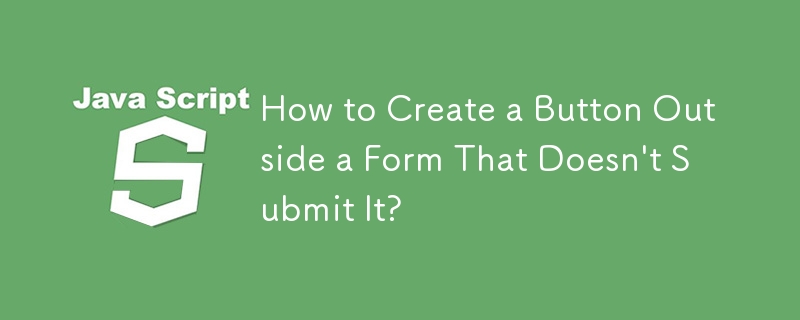How to Create a Button Outside a Form That Doesn\'t Submit It?
Oct 26, 2024 pm 03:59 PM
HTML Button to Resist Form Submission
Question:
How can one create a button outside an HTML form that does not submit the form when clicked?
Consider the following code:
<code class="html"><form id="myform">
<label>Label
<input />
</label>
</form>
<button>My Button</button></code>
Despite the absence of a form attribute in the button, it still submits the form.
Answer:
To prevent the button from submitting the form, it should be declared as a "button" type. Here's the updated code:
<code class="html"><button type="button">My Button</button></code>
Reason:
HTML buttons inherit the Submit Button state by default. By explicitly setting the type as "button," we override the default and prevent form submission.
The above is the detailed content of How to Create a Button Outside a Form That Doesn\'t Submit It?. For more information, please follow other related articles on the PHP Chinese website!

Hot AI Tools

Undress AI Tool
Undress images for free

Undresser.AI Undress
AI-powered app for creating realistic nude photos

AI Clothes Remover
Online AI tool for removing clothes from photos.

Clothoff.io
AI clothes remover

Video Face Swap
Swap faces in any video effortlessly with our completely free AI face swap tool!

Hot Article

Hot Tools

Notepad++7.3.1
Easy-to-use and free code editor

SublimeText3 Chinese version
Chinese version, very easy to use

Zend Studio 13.0.1
Powerful PHP integrated development environment

Dreamweaver CS6
Visual web development tools

SublimeText3 Mac version
God-level code editing software (SublimeText3)

Hot Topics
 Python vs. JavaScript: A Comparative Analysis for Developers
May 09, 2025 am 12:22 AM
Python vs. JavaScript: A Comparative Analysis for Developers
May 09, 2025 am 12:22 AM
The main difference between Python and JavaScript is the type system and application scenarios. 1. Python uses dynamic types, suitable for scientific computing and data analysis. 2. JavaScript adopts weak types and is widely used in front-end and full-stack development. The two have their own advantages in asynchronous programming and performance optimization, and should be decided according to project requirements when choosing.
 How to use JavaScript to determine whether two arrays are equal?
May 23, 2025 pm 10:51 PM
How to use JavaScript to determine whether two arrays are equal?
May 23, 2025 pm 10:51 PM
In JavaScript, you need to use a custom function to determine whether two arrays are equal, because there is no built-in method. 1) Basic implementation is to compare lengths and elements, but cannot process objects and arrays. 2) Recursive depth comparison can handle nested structures, but requires special treatment of NaN. 3) Special types such as functions and dates need to be considered, and further optimization and testing are required.
 Python and JavaScript: Understanding the Strengths of Each
May 06, 2025 am 12:15 AM
Python and JavaScript: Understanding the Strengths of Each
May 06, 2025 am 12:15 AM
Python and JavaScript each have their own advantages, and the choice depends on project needs and personal preferences. 1. Python is easy to learn, with concise syntax, suitable for data science and back-end development, but has a slow execution speed. 2. JavaScript is everywhere in front-end development and has strong asynchronous programming capabilities. Node.js makes it suitable for full-stack development, but the syntax may be complex and error-prone.
 How to set the attribute value of an element
May 23, 2025 pm 11:18 PM
How to set the attribute value of an element
May 23, 2025 pm 11:18 PM
Setting the attribute value of an element in JavaScript can use the setAttribute method or directly manipulate the attributes of the element. 1. Use the setAttribute method to set any type of attribute, including custom attributes, but the HTML attribute is set. 2. Directly manipulating the attributes of elements is more intuitive and suitable for common attributes, but custom attributes cannot be set, and the effects may be different for some attributes.
 How to implement data encryption with JavaScript?
May 23, 2025 pm 11:12 PM
How to implement data encryption with JavaScript?
May 23, 2025 pm 11:12 PM
Using JavaScript to implement data encryption can use the Crypto-JS library. 1. Install and introduce the Crypto-JS library. 2. Use the AES algorithm for encryption and decryption to ensure that the same key is used. 3. Pay attention to the secure storage and transmission of keys. It is recommended to use CBC mode and environment variables to store keys. 4. Consider using WebWorkers when you need high performance. 5. When processing non-ASCII characters, you need to specify the encoding method.
 Python vs. JavaScript: Choosing the Right Tool for the Job
May 08, 2025 am 12:10 AM
Python vs. JavaScript: Choosing the Right Tool for the Job
May 08, 2025 am 12:10 AM
Whether to choose Python or JavaScript depends on the project type: 1) Choose Python for data science and automation tasks; 2) Choose JavaScript for front-end and full-stack development. Python is favored for its powerful library in data processing and automation, while JavaScript is indispensable for its advantages in web interaction and full-stack development.
 How to achieve the rotation effect of element
May 23, 2025 pm 11:21 PM
How to achieve the rotation effect of element
May 23, 2025 pm 11:21 PM
To achieve the rotation effect of an element, use JavaScript combined with CSS3's transform attribute. 1. Use transform's rotate() function to set the rotation angle. 2. Realize dynamic rotation through requestAnimationFrame. 3. Consider reducing DOM operations or using CSS animations when optimizing performance. 4. Ensure browser compatibility and add prefixes. 5. User interactive control rotation is achieved through mouse or touch events.
 How to implement function anti-shake in JavaScript?
May 23, 2025 pm 10:57 PM
How to implement function anti-shake in JavaScript?
May 23, 2025 pm 10:57 PM
Function anti-shake is an optimization technique used to handle frequently triggered events. The implementation steps include: 1. Set a timer, clear the previous timer and reset the new timer every time the event is triggered; 2. If there is no new event trigger within the timer time, execute the defined function.






